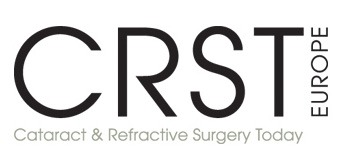RLE vs Corneal Inlays
Surgeons explain their preferences for presbyopia correction.
Alan Koh Kok Kiang, MD; Bernard Chan Kwok Loong; and Günther Grabner, MD
 |
WHY I PREFER REFRACTIVE LENS EXCHANGEAlan Koh Kok Khiang, MD; |
Changes in lifestyle and technology have always had a huge impact on medicine, and vice versa. Such advances can yield both negative and positive effects on patient care, treatment outcomes, and the ability to help patients not only solve an existing problem but also achieve better quality of life.
An example of this in ophthalmology is the treatment of presbyopia. With an aging population that is active and increasingly mobile, coupled with the introduction of myriad electronic devices that require good vision, many individuals around age 45 seek a way to get rid of their reading glasses and enhance their daily lives. This is especially common among patients who have previously had LASIK.
To address this need, we at Vista Eye Specialists introduced conductive keratoplasty (CK) in 2004 and the Kamra corneal inlay (AcuFocus) in March 2011. Our aim in implementing these procedures was to offer patients in our community the option to restore their reading vision. By March 2012, we were the top implanter of the Kamra inlay in Southeast Asia and one of the top three implanters in the Asia-Pacific region.
However, over the years, we encountered issues with corneal inlays that prompted us to go in another direction. With the introduction of laser-assisted cataract surgery (LACS) and improved multifocal IOL technologies, refractive lens exchange (RLE) became my procedure of choice for presbyopic patients without cataracts or with very early cataracts. In my experience, RLE has gained popularity among our patients, offering better results and overall greater patient satisfaction.
THE DOWNSIDES OF INLAYS
As noted, various challenges with corneal inlays were seen in our practice in the 3 years we were implanting them. Many of these issues were to be expected, but some turned out to be more serious than we originally thought.
Dry eye. Even with the use of a tunnel procedure for implantation, dry eye was a constant source of postoperative complaints for many patients.
Visual quality. In many cases, we performed LASIK on the patient’s inlay eye, targeting -0.75 to -1.00 D, before implanting the inlay. This, however, compromised patients’ distance vision in this eye, and, when coupled with poor lighting conditions at night, proved to be a hindrance to night driving. Only 44% of patients who had an inlay implanted at our practice from 2011 to 2014 maintained 6/7.5 or better distance vision on postoperative day 1, and only 59% and 62% achieved that quality of vision by 1 month and 1 year, respectively.
Lighting dependence. Although corneal inlays enhance near vision, patients still need sufficient light to read small text over long periods.
Monovision. Near reading with the nondominant eye is not a perfect solution to presbyopia, and our inlay patients also complained that it was tiring to read over long periods.
Contraindications. Success with inlay technologies depends on strict patient selection. Patients must be excluded if they have had previous ocular surgery or ocular pathologies including keratectasia, corneal degeneration, severe blepharitis, retinal disease, glaucoma, cataract, topographic irregularity, or severe dry eye. If these conditions are present, they must be treated aggressively before surgery can be performed.
Impermanence. The benefit of corneal inlays is temporary, as cataract becomes an issue as patients age.
Corneal haze. As many as 50% of our patients developed corneal haze of various degrees, in some cases affecting their vision.
Surgery time. The inlay procedure can take up to 30 minutes to perform, and sometimes longer if repositioning is required. The surgical time can be increased if the surgeon attempts the implantation without the specific technology required.
Learning curve. Inlay implantation mandates a new learning process for the surgeon.
No wow factor. Due to the period of neural adaptation needed, it took longer for my inlay patients’ vision to stabilize and for them to achieve a degree of independence from their glasses. On postoperative day 1, only 32% of our patients achieved N5 UNVA; this improved to 88% at 1 month.
Given the challenges described above, in many cases we offered patients the option to have their inlays removed. However, only one patient out of the hundreds we treated proceeded with explantation, as the inlay procedure had worsened her vertigo problem. Inlay implantation, an external procedure affecting only the anterior cornea, was perceived to be safer by patients than an intraocular procedure such as RLE.
THE UPSIDES OF RLE
Patient satisfaction was the key factor in our decision to choose RLE over corneal inlays for presbyopia correction. Since introducing LACS and segmented multifocal and varifocal IOLs (Lentis MPlus family; Oculentis) in our practice in 2011, RLE has become more popular among our surgeons and patients, and I have seen many benefits.
Visual quality. When IOLs are implanted bilaterally, visual quality is significantly improved and stable after RLE. In our practice, on postoperative day 1, more than 72% of patients see N5 UNVA, 100% see 20/25 UIVA, and 78% achieve 6/7.5 UDVA. At 1 year, 100% of patients achieve at least N5 UNVA or better, at least 20/25 or better for UIVA, and at least 6/9 or better for UDVA.
Lighting independence. With varifocal IOLs, patients report fewer visual disturbances in poor lighting conditions, even when driving.
Permanence. Patients can accept the RLE procedure, as it saves them from having to undergo cataract surgery later in their lives, at a time when they could potentially face other health issues that could complicate cataract surgery.
Customization. Depending on the patient’s needs and lifestyle, the surgeon can select the specific IOL that will provide the vision he or she desires.
Immediate wow factor. With proper operative technique, patients can achieve good near, intermediate, and distance vision on day 1 after RLE.
OPEN COMMUNICATION REQUIRED
Granted, there is higher risk associated with intraocular surgery than with a corneal inlay. However, this is manageable due to the relatively young age of RLE patients. With the right surgical technology, such as LACS, the only major concern with RLE revolves around the ethical debate of removing the crystalline lens of a young patient. We have worked to address this by openly communicating with our patients about their expectations and concerns. The high-quality results and positive patient feedback we receive have made us confident in our decision to treat presbyopia with RLE.
VS
 |
WHY I PREFER CORNEAL INLAYSBy Günther Grabner, MD |
For the dedicated refractive surgeon, choosing between RLE and corneal inlays for presbyopia correction is not always simple. Many points in the decision-making process require careful consideration. Key factors include proper patient selection, adequate patient education, and competent surgical skills and training in this specific type of corneal surgery.
Most eye surgeons learn to perform cataract surgery during training and, thus, generally find RLE to be an easy procedure, given the soft nucleus and healthy state of the eyes in this younger patient population. Achieving a truly good result with corneal inlays, however, requires meticulous surgical technique, adherence to specific guidelines, and well-tuned laser equipment.
A crucial factor in choosing between RLE and corneal inlays is the patient’s expectations and daily needs, with easygoing personality types carrying a clear advantage. Another important factor is patient age: As a general rule, any sign of incipient cataract in either eye, no matter how minimal, shifts the balance toward RLE. This makes RLE the procedure of choice for patients aged 60 years or more.
Few patients will be more grateful after RLE than hyperopic presbyopes, who have been dependent on multifocal spectacles but have good CDVA. Emmetropes and low myopes, however, are a different story. These patients will be more reluctant to undergo bilateral RLE, as they have enjoyed good UDVA and the ability to read without glasses for a prolonged time. In these scenarios, the aim of RLE must be a near-perfect UDVA, including the correction of astigmatism as low as 0.75 D.
A major advantage of operating at the corneal plane is the fact that the treatment essentially remains an extraocular procedure. Further, in the rare case of patient dissatisfaction, the surgery can be successfully reversed if the inlay is explanted in the early postoperative period.
OTHER OPTIONS
Presbyopic LASIK (presby-LASIK) techniques have been in use for nearly 30 years and finally seem to have reached a point at which they can satisfy most patients. Decentering ablations as a way to achieve presby-LASIK is no longer used, but central and peripheral presby-LASIK techniques have been studied extensively.1 Central presby-LASIK works well for near vision, but it does not perform as well with distance vision. Peripheral presby-LASIK is good for distance vision and has a good safety record, but it provides limited near vision. Patient satisfaction is generally high with either approach, but some patients can lose up to 2 lines of UNVA.
However, it is important to remember that laser correction is a static modification of a dynamic process. Micro-monovison, as studied extensively by Dan Z. Reinstein, MD, MA(Cantab), FRCSC, DABO, FRCOphth, FEBO, seems to offer distinct advantages, including excellent stereovision, high patient satisfaction, good bilateral visual acuity, and easy correction.2
Other approaches that depend on thermal shrinkage of the corneal stroma, such as thermal keratoplasty (TKP), laser TKP, and CK, have been promoted over the past few decades. However, these procedures did not gain widespread use and disappeared from the market due to massive regression and induction of glare and astigmatism. A similar principle is used in the Intracor procedure (Bausch + Lomb Technolas), in which the femtosecond laser is used to perform a deep intrastromal and pericentral treatment and induce change in corneal shape.
ADVANTAGES OF CORNEAL INLAYS
The implantation of corneal inlays was initially described by José Barraquer, MD, in the 1950s. Indeed, the corneal stroma seems to be the best location for placing microimplants to treat presbyopia. The two major advantages of intrastromal inlays are that (1) they are tissue-sparing, as no tissue is removed, and (2) they are easily removable.
However, there are also a couple of challenges that have been solved only in the past decade after dedicated research. These include identifying biocompatible materials and designs, verifying that the optics are effective and yield predictable results, and establishing stability over long periods.3
Multiple inlay technologies are now available, including intrastromal microlens systems such as the Raindrop Near Vision Inlay (ReVision Optics), Icolens (Neoptics), and Flexivue (Presbia) and the small-aperture, extended depth of focus Kamra inlay (AcuFocus). The Kamra has been implanted in more than 3,000 patients in the United States in the past year and in more than 22,000 eyes worldwide since the launch of clinical investigations.4,5
All of these corneal implants are highly biocompatible, and they are almost fully reversible. If the patient is unhappy with his or her results, the implants should be removed early in the postoperative period. Afterward, the cornea will essentially revert back to its normal state and preoperative refraction.
MY ADVICE
In my experience, pearls for presbyopia correction include:
• Manage patient expectations properly;
• Always have an exit strategy; and
• If the patient is unhappy with a corneal implant, explant it early.
For younger patients who do not have cataracts and do not want to risk intraocular surgery, corneal techniques offer better safety and are reversible. Further, there are no associated risks of endophthalmitis, capsular rupture, refractive surprise (as with IOLs), vitreous loss, retinal detachment, or secondary cataract. This is why, in my view, the cornea is the place to treat presbyopia in young, carefully selected patients.
Reference
1. Pallikaris PG, Panagopoulou SI. PresbyLASIK approach for the correction of presbyopia. Curr Opin Ophthalmol. 2015;26:265-273.
2. Reinstein DZ, Carp GI, Archer TJ, Gobbe M. LASIK for the correction of presbyopia in emmetropic patients using aspheric ablation profiles and a micro-monovision protocol with the Carl Zeiss Meditec MEL80 and VisuMax. J Refract Surg. 2012;28:531-541.
3. Dexl AK, Jell G, Strohmaier C, et al. Long-term outcomes after monocular corneal inlay implantation for the surgical compensation of presbyopia. J Cataract Refract Surg. 2015;41:566-575.
4. Waring VI GO, Faria-Correia F. Cornea-based techniques and technology for surgical correction of presbyopia. Curr Ophthalmol Reports. 2014;2:41-47.
5. Arlt EM, Krall EM, Moussa S, Grabner G, Dexl AK. Implantable inlay devices for presbyopia: the evidence to date. Clin Ophthalmol. 2015;9:129-137.






























